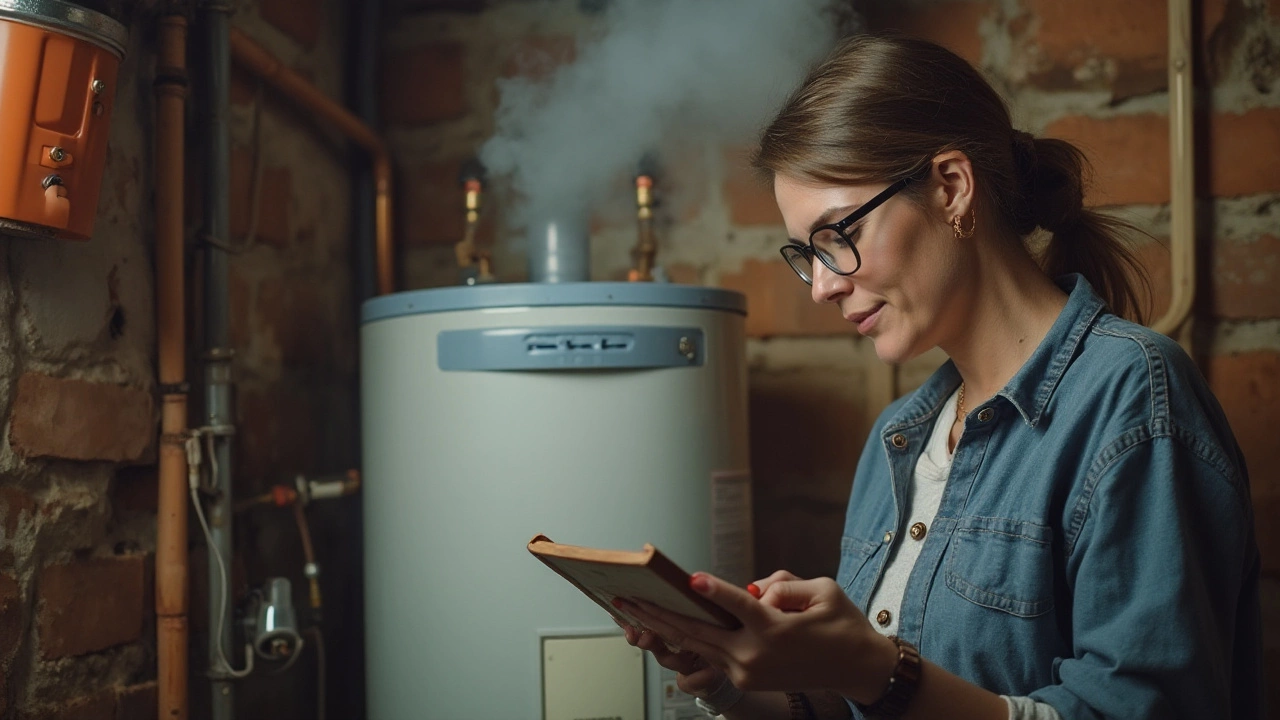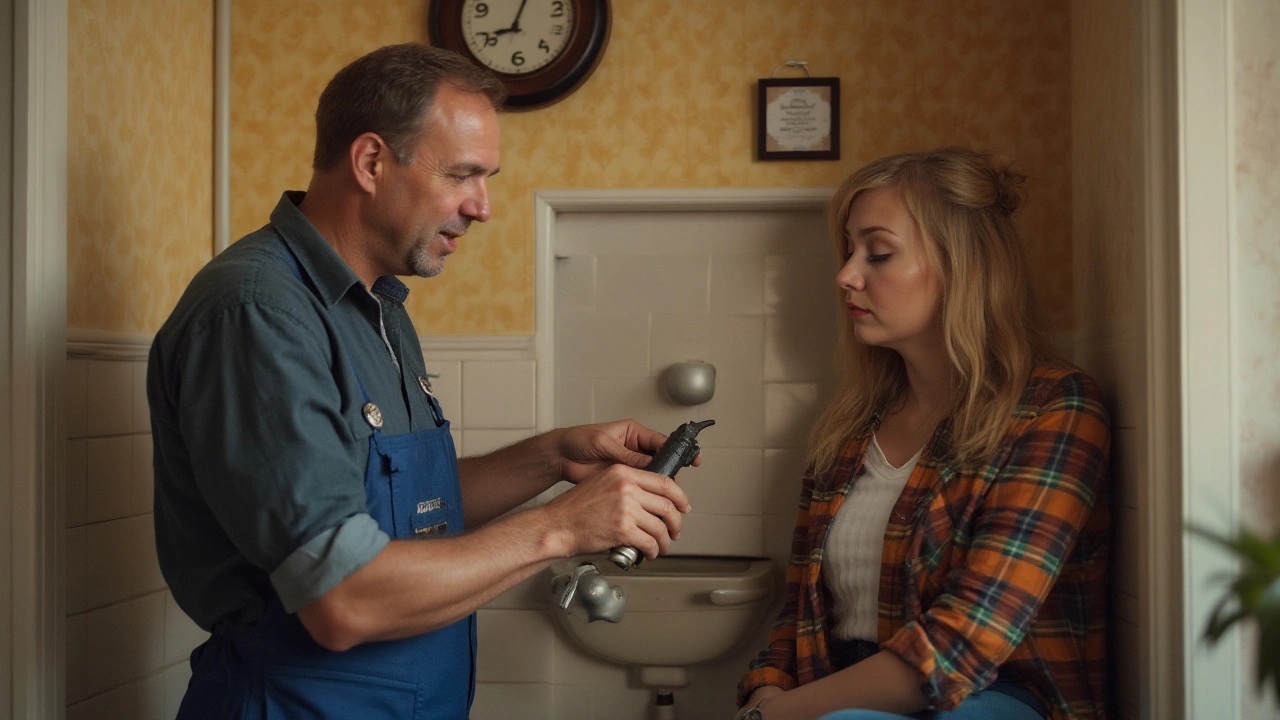Water heaters are the unsung heroes of modern comfort, keeping those hot showers and baths ready for us without a second thought. But just like any diligent worker, they can run into a few hiccups as they age and labor. Understanding these blips and acting swiftly can save you not only time but also a bundle of cash.
Think about some typical hiccups — the water isn't as hot, or worse, isn't hot at all. Maybe there's a puddle forming around the unit, or you hear strange churning noises. All these signs point to different gremlins at work within your heater. Knowing what usually fails in water heaters can arm you with the knowledge needed to tackle these issues head-on or recognize when it's time to call in the cavalry.
- Introduction to Water Heater Failures
- Common Issues and Symptoms
- Thermostat and Heating Element Problems
- Tank Leaks and Sediment Build-up
- Regular Maintenance Tips
- When to Call a Professional
Introduction to Water Heater Failures
It’s a chilly morning, and you're counting on a steaming shower to kickstart your day. Then, the water hits—lukewarm at best, tepid at its worst. It’s at that moment the realization sinks in; something is amiss with your trusted water heater. Most people don’t give these appliances a second thought until there’s a noticeable issue. Given the arduous job these heaters perform, it’s no surprise they hit a snag after years of service. Yet, like understanding a car's rattle before it breaks down, spotting subtle signs of trouble can save you from waking up to a cold shower.
In many households, the water heater is a core component of daily comfort, delivering hot water for showers, dishwashing, and more. But these workhorses aren't invincible. According to a study by Energy.gov, water heaters account for nearly 20% of a home's energy use, making them one of the largest energy expenses. This increased demand subjects the units to wear and tear over time, often resulting in operational failures if not addressed on time. Many folks mistake minor glitches for seasonal quirks or water pressure issues, but sometimes these are flags for deeper problems.
"A well-maintained water heater can last a decade or more," says Emily Shaw, a leading expert in home appliances. "But neglect can halve its lifespan, causing inconvenient breakdowns and costly repairs."
Several factors contribute to these hiccups, and learning about them can keep you ahead of the curve. Problems can range from sediment build-up, and faulty thermostats, to leaky tanks — each with unique signs that often go unnoticed until the issue worsens. Sediment build-up, for instance, is a classic culprit, especially in areas with hard water. As the heated water precipitates minerals like calcium and magnesium, they settle at the bottom, reducing the heater's efficiency and leading to rumbling noises.
Understanding the Warning Signs
Knowing when to book a service appointment is crucial. As water heaters age, the risk of them breaking down increases. Watch out for signs like inconsistency in water temperature, odd noises emanating from the unit, or even a decline in water pressure. Each symptom, while minor in isolation, can herald significant underlying damage. Peeling paint or corrosion around the tank's base can indicate leaks. It's these whispers of dysfunction that can guide preemptive repair measures, creating less disruption in your routine.
By equipping yourself with this knowledge, you lay the groundwork for timely interventions. In doing so, you enhance the longevity of your water heater and ensure an uninterrupted supply of that much-coveted hot water. As the complexities of domestic life evolve, these practical insights and swift actions add invaluable peace of mind.
Common Issues and Symptoms
You wake up ready for a soothing hot shower, only to be startled by a rush of icy water – a classic sign that your water heater might be experiencing trouble. Though these appliances are known for their reliability, they’re not immune to woes. Knowing the symptoms of common problems can help you diagnose and even resolve minor issues before they morph into major headaches. These devices, after all, work silently in the background until one day they don’t, and suddenly that mundane piece of equipment commands your full attention.
One of the first symptoms to catch the eye or ear is unusual noises. If your water heater sounds like a popcorn machine, it’s time to take note. These noises primarily result from sediment build-up at the bottom of the tank. Over time, minerals from hard water settle and harden, reducing the heater’s efficiency and leading to overheating and strange sounds. Another significant symptom is when water temperature varies wildly. A malfunctioning thermostat or a faulty heating element might be to blame, representing common reasons homes intermittently get either scalding or tepid water.
Leaks are another glaring issue but don’t always suggest a death sentence for your heater. While a steady drip might mean a doomed tank, minor leakage could simply be due to a faulty valve or fitting. Often, homeowners notice leaks due to corrosion which happens as the heater gets older. It’s critical to assess these leaks promptly, as unchecked water escape can spur structural damage or mold growth in your home. The discoloration of water that meets your skin or cooking pots is also a notable sign. Rusty or cloudy water often means corrosion within your tank itself or possible issues in sacrificial anodes that need replacing.
Now, consider the water’s flow. Minimal pressure from hot water taps can indicate blockage. This obstruction usually stems from the aforementioned sediment or mineral build-up, which can clog pipes and reduce water throughput. A rather pesky nuisance, low water pressure can make showers less enjoyable and disrupt dishwasher and washing machine efficiency. If these symptoms are cropping up, it might just be your heater's way of waving a white flag, asking for a bit of TLC or professional intervention.
"A good rule of thumb is to always pay attention to your water heater’s behavior. Ignoring it is like ignoring an early symptom of a cold," advises Eric Hobbs, a veteran plumbing specialist from Vancouver, who encourages routine checks.
Every symptom may suggest its own tale of misfortune, but each is a valuable clue towards solving the mystery of your unruly heater. Keeping an eye out for these common issues helps you know when a simple maintenance task might suffice or when it’s time to consider a replacement entirely. Water heaters, in all their humble usefulness, remain critical allies in our everyday lives, and knowing their language can extend their service even further.

Thermostat and Heating Element Problems
Diving into the world of water heater issues, the thermostat and heating elements are often at the heart of the problem. These components are the brains and muscles of a water heater, respectively. Let's paint a picture: the thermostat regulates the water temperature and signals the heating element to kick in. If the water is lukewarm or icy cold, blaming the thermostat is often a good start. A stuck or broken thermostat won't allow the heating elements to warm up properly, leaving your water cool and your showers brisk.
A common symptom of a faulty thermostat is inconsistent water temperatures. One day your shower feels like you're on a tropical beach, while the next day it’s like stepping into a cold mountain stream. This erratic temperature fluctuation can be traced back to a thermostat unable to maintain its setpoint accurately. Diagnosing a defective thermostat would require testing it with a multimeter, a device that measures electric currents. For those DIY enthusiasts, checking these readings against the recommended figures in your heater’s manual can tell you if it’s time to swap out the thermostat.
The heating elements themselves are crucial too. They are tasked with generating the heat necessary to bring that chilly water straight from your pipe up to a toasty, comfortable level. Over time, these elements can corrode or even break, leading to noticeable changes in performance. Regular maintenance checks help catch these issues early. Replacing a heating element isn't as complex as rocket science but does require careful adherence to safety protocols — turning off the power supply and draining the tank, for instance.
To put things into perspective, let's consider the average lifespan of these components. Typically, thermostats and heating elements are designed to last six to ten years if well cared for. Of course, local water quality plays a part here, as hard water can speed up wear and tear. If you spot sediment build-up or hear popping noises, those can be subtle hints of heating element trouble on the horizon.
"Regular maintenance of your water heater can extend its life by up to 50%," notes an expert from the Canadian Water Quality Association. This underscores the importance of keeping an eye on these components before they reach a breaking point.
Beyond the basics, it’s worth noting that modern water heaters sometimes feature dual heating elements. This design provides more efficiency and faster water recovery times. With two elements taking turns in the task, one can often cover for the other when things start to go awry. However, this also means double the potential for problems if not regularly maintained.
In summation, knowing the signs of thermostat and heating element problems and addressing them with timely care not only ensures that your morning routines remain blissfully warm but also extends the life of your trusty water heater. If issues persist, never hesitate to reach out to a professional. Mastering the art of heater upkeep combines DIY spirit with the wisdom of knowing when to call in the experts.
Tank Leaks and Sediment Build-up
Tank leaks can be the most unwelcomed guests in your water heater's lifespan, and understanding why and how they occur is vital for every homeowner. The main culprit of these leaks is corrosion. Over time, your water heater's metal tank undergoes rust due to constant exposure to water. This rust weakens the tank's structure, eventually leading to small holes or cracks, allowing water to escape. It's crucial to spot any leakage early; as soon as you notice drips or water pooling around the heater, action is paramount to avoid costly damage.
Another insidious problem that closely follows leaks is sediment build-up. This happens when minerals like calcium and lime in your water supply settle at the bottom of the tank. Sediment build-up not only decreases your tank's capacity but also acts as insulation between the water and the heat source, making your heater work harder to heat water efficiently. In some cases, this additional strain can lead to overheating or even premature failure of the heating element. Draining your tank at least once a year can help flush out these sediments and keep your heater operating smoothly.
The sound of rumbling or popping noises from your heater often signals that sediment is present. The noises occur when steam bubbles rise through the layer of sediment as it heats the water, causing disturbances. Regular cleaning and maintenance are pivotal in avoiding this problem, prolonging your heater's life, and saving on energy costs. According to an energy expert, "A water heater loses approximately 1% efficiency per year due to sediment build-up." So, regular sediment flushing isn’t just about extending lifespan; it's also about efficiency and money savings.
Detecting leaks in your water heater is as crucial as addressing them. One practical method is the visual inspection of parts of the heater with a flashlight, especially around the tank's base and connections. Wetness or rust marks are strong indicators of leaks. If a leak is detected early and isn't too severe, repairing damage with epoxy or replacing faulty valves could solve the issue. However, if the tank itself is compromised, replacement might be the most sensible option. Remember, prevention is better than cure, so installing a water softener can reduce mineral content in your water supply and thus minimize sediment buildup.
For those who prefer numbers and statistics, an inspection every six months combined with annual maintenance increases your water heater's lifespan by an average of 39%, according to recent data. Although water heater repair can sometimes seem daunting, knowledge is power. Knowing your heater's weak points helps you stay ahead of potential failures, saving time, hassle, and cost.

Regular Maintenance Tips
Regular upkeep of your water heater is crucial if you want to enjoy hot water without interruptions. Just like maintaining a car, keeping things in check ensures you're not left stranded unexpectedly. The first step in water heater maintenance is examining the unit for any signs of trouble. A simple visual inspection can go a long way. Look for rust or corrosion on the outside of the tank, and pay attention to any water pooling around the base. Both these signs can indicate potential leaks or problems brewing inside the tank. Remember, catching issues early can prevent costly repairs down the line.
Another vital practice is to flush your water heater tank annually. Over time, sediments like calcium and magnesium settle at the bottom, leading to decreased efficiency and even damage. To flush your tank, turn off the power or pilot light, hook a hose to the drain valve, and empty the tank into a nearby drain. Refill and repeat the process until the water runs clear. This simple act can extend the life of your heater remarkably.
Inspecting the Anode Rod
The anode rod plays a crucial role in preventing tank corrosion. It's a sacrificial component, designed to corrode in place of the tank. Checking this rod every couple of years is essential. If the rod is heavily corroded or less than half an inch thick, it's time for a replacement. Keeping the anode rod in good shape can significantly prolong the life of your heater. As noted by the U.S. Department of Energy, maintaining the anode rod can add years of service to your water heater.The thermostat settings also deserve your attention. Manufacturers often set the thermostat to around 140 degrees Fahrenheit by default, which is hotter than most households need. Lowering this to 120 degrees can save energy and reduce the risk of mineral build-up. Not to mention, it helps in making your water heater more kid-friendly by reducing the risk of accidental scalding.
Lastly, while you can tackle most maintenance tasks yourself, don't shy away from calling a professional for an annual check-up. A technician will not only perform a more thorough cleaning and check for unseen issues but can also offer peace of mind with their expertise. Remember, regular maintenance is not just about prolonging the life of your water heater, but ensuring the safety and comfort of your home.
When to Call a Professional
Recognizing the moment when your trusty water heater needs the expertise of a professional can sometimes be a challenge. We've all been there, tinkering with gadgets and plumbing while hoping for a miraculous fix. But there are times when even the most determined DIY spirit must step aside. Knowing these times is crucial not only for the health of your heater but for your household's safety. When you notice a significant drop in performance, strange noises that persist after simple fixes, or persistent leaks, it's best to call in an expert. Sometimes, these issues hide underlying problems that only a skilled technician can diagnose accurately.
Take the case of the thermostat or the heating element mishaps. You might think replacing them is a straightforward task, and sometimes it can be, especially if you are quite handy. But modern water heaters have layers of intricacies, from electrical components to smart controls, that shouldn't be tampered with lightly. Incorrect handling not only risks damaging the heater further but could also void its warranty. An expert knows the ins and outs, ensuring repairs are done to standard, preserving your warranty, and giving you peace of mind.
Consider tank leaks. These might start as mere drips or damp patches under your unit. However, if left unattended, they can escalate to major spills, causing water damage to floors and walls. Technicians are trained to identify the source of leaks, whether it's due to faulty valves, piping issues, or tank corrosion, and can recommend the best course of action, be it a repair or a complete replacement, which might not be apparent to the untrained eye.
According to the U.S. Department of Energy, water heaters account for about 18% of a home's energy use, making them the second-largest expense in most households. Inefficient heater operation can skyrocket those energy bills. If you've noticed a spike in your energy costs without a change in usage, it might be time to have a professional assess your heater's efficiency. They can check for elements like sediment build-up or issues with insulation, both of which could impact energy consumption.
"A timely inspection by a certified professional can extend the life of your water heater by up to five years," notes a representative from the National Association of Home Builders.Regular water heater repair checks can help extend the lifespan of your unit unexpectedly past the average 10-15 years, turning small investments into long-term savings. Remember, not every problem can be solved with a quick trip to the hardware store.
